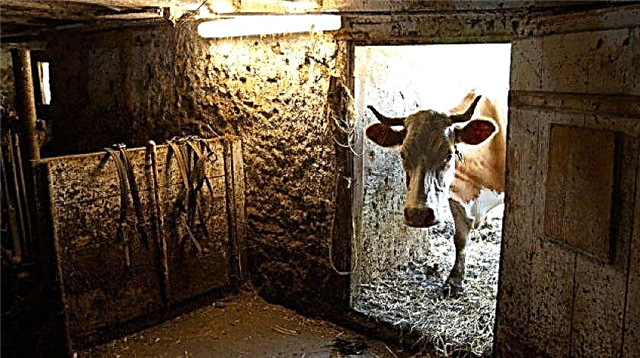Discharges from a cow before and after calving can indicate different pathological conditions, from damage to the uterus to the development of serious diseases. Let's see which of them should be paid attention to and how to help the animal.
Discharge before and after calving
Vaginal discharge in the cow before and after calving does not necessarily indicate a painful condition. Some of them are quite natural for the physiology of the animal. Consider how much, duration and condition of the discharge in a cow does not require therapy, and what you need to pay attention to and take timely measures to prevent the development of gynecological diseases.
Norm of discharge
Before calving transparent discharge is normal. The fluid should be viscous and have a mucus consistency. A variant of the norm includes the presence of a specific smell. This type of vaginal secretion is considered a harbinger of labor and promotes easy delivery by reducing friction during the process.
After calving lochia containing blood, mucus and particles of uterine tissue come out of the uterus of the cow. At first they look like blood clots, after which they become more mucous.
Did you know? The postpartum period in cows generally lasts 21—28 days. During this period, the lochia should completely go out, the cervical canal closure, the uterus and the corpus luteum involution, and the stage of the excitation of the first postpartum sexual cycle should appear.
When do calving begin?
Transparent mucus from the vagina begins to go out after about 12—20 hours before the cow begins to calve. It lubricates the birth canal, along which the fetus will move. The mucus is plentiful and has a rather thick consistency.
How long does the cow last after calving?
Postpartum discharge of Lochia from the uterus lasts 2 weeks. At first they go constantly due to the contraction of the uterus. After a week, the frequency decreases, lochia take the form of blood with mucus. After a maximum of 15 days, the discharge should completely stop.
Did you know? Symptoms of the approaching delivery in addition to mucus from the vagina are swelling of the udder and colostrum, swelling of the labia, shyness of the animal and a desire to retire.
Pathological discharge and methods for their treatment
If the secretion of a cow differs from the described norm, there is a likelihood of a pathological process. Different types of secretions and associated symptoms can indicate dangerous diseases, such as vaginitis, endometritis, and vaginal injuries. Timely diagnosis will help determine what measures to take and how to treat the animal. First of all, you need to pay attention to such characteristics of the animal's secret as color and smell.
White or yellow
White discharge after calving indicates the presence of vaginitis — inflammatory process in the vagina. After a while, they become yellowish. If you do not pay attention to the symptom in time, it is possible to transform the mucous consistency into a granular and the appearance of blood impurities. After confirming the diagnosis, the vagina is cleaned, washed with a solution of potassium permanganate and treated with streptocid or ichthyol ointment. Further, the cow needs to undergo a course of antibacterial drugs and take vitamin and mineral supplements. This symptom after childbirth can also be a sign of endometritis.
Purulent
Pus in the discharge can occur after calving. A secret containing pus indicates the development of purulent-catarrhal endometritis or endometritis in a chronic form. The diagnosis is confirmed by concomitant symptoms in the form of spotting and putrid odor. The treatment is prescribed by the veterinarian, most often injected with Oxytocin and the intrauterine administration of Rifapol.
Bloody or brown
Prenatal mucus with blood indicates vascular damage when the fetus passes through the birth canal. Allocated in this case may be pink. To treat this pathology after childbirth, the condition of the uterus is checked and a solution of furacilin or potassium permanganate is administered. To prevent infection, the cow is prescribed antibiotics in the form of vaginal suppositories.
Brown discharge from the vagina before calving indicates bleeding. A similar situation can occur due to severe damage to the birth canal. If there are blood clots in the discharge, there is uterine bleeding. A uniform consistency indicates vaginal injuries. With uterine bleeding, the fetus and the afterbirth should be removed. After childbirth, it is necessary to examine the genitals using a gynecological mirror. In case of large blood loss, saline and glucose must be administered intravenously or with an enema.
Intrauterine bleeding is treated with the following medicines:
- "Oxytocin" intramuscularly (60 IU);
- ichthyol solution 1% (0.33 ml per 1 kg of weight) intravenously;
- 200 ml of a solution of sodium chloride 10% intravenously;
- vitamin-mineral supplements (vitamin C, K, "Vikasol", "Biocalcium", "Biotsink").
Also, in the case of brown discharge in front of the calving, the cause may be intrauterine bleeding due to the incorrect position of the fetus with the hooves up. In this case, the obstetric assistance of a veterinarian is required to turn the calf over manually. If these manipulations do not succeed, it is necessary to resort to a surgical method of delivery. The absence of lochia after childbirth and the appearance of bloody discharge from the vagina by 4—Day 5 indicates the development of postpartum endometritis. This disease is characterized by an inflammatory process in the internal mucous surface of the uterus. Possible increase in temperature and loss of strength in the animal. Lochia come out only after pressure on the uterus.
The absence of lochia after childbirth and the appearance of bloody discharge from the vagina by 4—Day 5 indicates the development of postpartum endometritis. This disease is characterized by an inflammatory process in the internal mucous surface of the uterus. Possible increase in temperature and loss of strength in the animal. Lochia come out only after pressure on the uterus.
Important! Instruments should be used with caution, as they can aggravate bleeding.
For drug treatment, drugs are used:
For treatment by the folk method, a cow should drink a decoction of St. John's wort and yarrow in equal parts.Bad smell
An unpleasant odor is often associated with yellow, purulent, or bloody discharge. This symptom may also be an indicator of the development of endometritis.
Important! The use of any drugs must be agreed with a specialist!
First aid for unusual discharge
If an unusual discharge occurs, it is advisable to consult a veterinarian, since subsequent treatment depends on the etiology. You can give the cow first aid before the arrival of a specialist, it consists in the following actions:
- Disinfect the room where the animal is located.
- The cow should be in a calm atmosphere.
- Keep track of the dynamics of the selection, output frequency, quantity and color.
- Wash the genitals with a weak solution of potassium permanganate.
- Prepare a solution of 3% from alum and 1% pioctannin. This tool can irrigate or lubricate the vagina.

Gynecological Disease Prevention
Preventive measures regarding gynecological diseases should be applied from the moment of insemination until the end of postpartum recovery. The following rules must be observed:
- Do not allow trauma to the animal.
- Contact with sick animals is desirable to exclude; if a cow in the stock is sick, it must be isolated.
- Appropriate care should be taken.
- The diet of the cow should be formed from quality feed and additives.
- It is unacceptable to depart from accepted sanitary standards.
- Chronic and acute diseases need to be treated on time, without leaving the cow in an untreated state.
Allocations before and after calving can be both a variant of the norm and evidence of the development of the pathological process. For a successful delivery and subsequent life of a cow and a calf, it is important to identify symptoms and treat them on time. Proper help will save the cow not only health but also life.












